Our Vacation in India
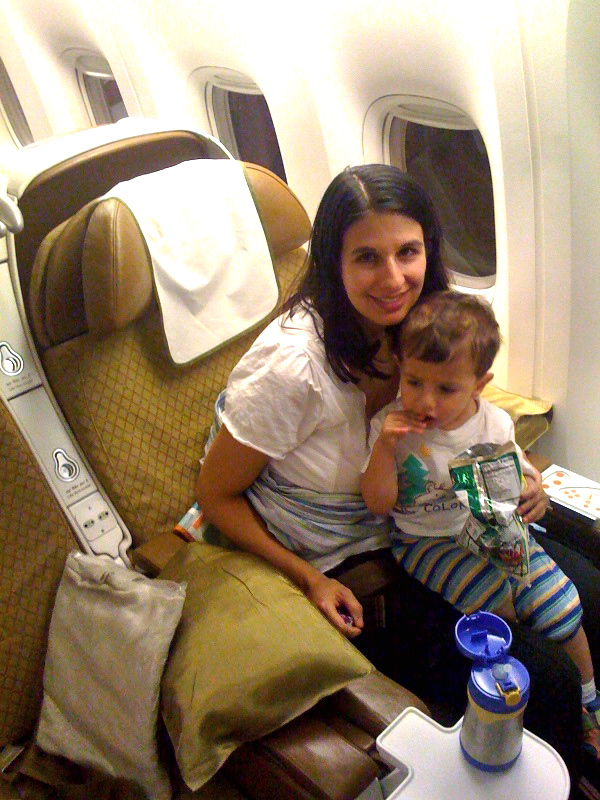 In 2007, Robert and I planned to go to India for a couple weeks. We figured that we were young and healthy, with stamina and a sense of adventure, so we might as well go somewhere amazing but kind of hard to travel around in now, rather than later--we can always tour Western Europe when we're old, after all. Well, after we had our shots and our reservations and our visas and everything, there was an illness in the family and we ended up having to cancel our trip. The next year, I was six months pregnant and didn't relish the thought of lots of travel, humidity, and long flights. The next year, we had a (somewhat small) baby, so we did one of those Western Europe trips because it seemed safer at the time. This year, we figured we might as well do the India trip--Marcus is portable, and as long as he's under two years old he still flies free, so despite my parents' repeated requests for us just to "leave the baby" with them, we ended up going to India (9.5 hours ahead of Boston/New York as far as the time change goes) as a family of three. At right: snacking in business class on Air India on the way over.
In 2007, Robert and I planned to go to India for a couple weeks. We figured that we were young and healthy, with stamina and a sense of adventure, so we might as well go somewhere amazing but kind of hard to travel around in now, rather than later--we can always tour Western Europe when we're old, after all. Well, after we had our shots and our reservations and our visas and everything, there was an illness in the family and we ended up having to cancel our trip. The next year, I was six months pregnant and didn't relish the thought of lots of travel, humidity, and long flights. The next year, we had a (somewhat small) baby, so we did one of those Western Europe trips because it seemed safer at the time. This year, we figured we might as well do the India trip--Marcus is portable, and as long as he's under two years old he still flies free, so despite my parents' repeated requests for us just to "leave the baby" with them, we ended up going to India (9.5 hours ahead of Boston/New York as far as the time change goes) as a family of three. At right: snacking in business class on Air India on the way over.
Mumbai
We flew out from JFK to Mumbai on Air India Sunday night, May 9th (Mother’s Day). We were supposed to have gone the day before on Air France via Paris, but our A380 couldn’t land in NY since it was kind of windy, so the plane was diverted to (ironically) Boston, and Air France rerouted us on a nicer, more direct flight anyway. We also got to spend Mother’s Day with my mother, so—as my father loves to say—it all worked out for the best.
At JFK, the Air India business-class representative whisked us through check-in and security. It was like something out of a movie, with us being white-gloved through ahead of the teeming mobs of steerage (er, coach) passengers. One family with a baby pled with our representative, and she finally relented and let them pass to the next checkpoint along with us. Marcus had his first meltdown of the trip when he had to leave his shoes on the conveyer belt. “Shoes! Shoes!” our boy screamed, happy only when we were through the metal detector and buckling them back on his feet.
The first-class Air India lounge had a lovely viewing window out to the runway, which Marcus liked, and snacks. Baby grabbed a cauliflower pakora happily and chomped on it, and then his little mouth opened, the lower lip let the pakora dribble out, and he started wiping off his tongue. “Hot!” Yep, baby, we’re going to India—even the airplane food was spicy, noticeably so to me, and sometimes uncomfortably so for baby. When it was time to board, another representative whisked us straight to our seats, where we got to sit for almost three hours because the wind made only one runway be open. We ended up landing a couple hours late in Mumbai, unable to make up time because of the Icelandic volcano ash cloud rerouting planes over Europe.
The flight itself was wonderful, though, with comfy lie-flat seats. Marcus fell asleep in the sling while we were still on the ground, and before take-off he and I went to bed and slept about nine hours straight. They served dinner while we were still on the ground, then breakfast, and then snacks (meaning not bags of chips, but something more substantial-pakoras, fried shrimp, you know, just some snacks) just before we landed. I had Indian, veg, The flight attendants and the other passengers were all friendly—an older man, retired, started talking to Robert about game theory at one point, and a husband and wife flight attendant pair was charmed by Marcus and gave him two cheap, clearly-not-meeting-US-safety-standards Air India stuffed toys (an eye came off immediately—possibly in baby’s mouth). Marcus loved them, though, promptly kissing them. He took another nap before we landed, but mostly played happily through the flight, making a nest of pillows and blankets at our feet (we had bulkhead seats), coloring, building with Legos, driving a little car around, etc.
Interestingly, before we flew I had read an online review that said something like “Don’t fly Air India unless you are prepared for the smell of curry and the wild children running up the aisle.” Well, we were prepared for both, and it seemed the other passengers were, too. Marcus definitely had moments when he went over and pushed the buttons on other passengers’ seats, trying to recline them, but generally he had a really good flight. Robert said Marcus and I were clearly the two most comfortable people on the entire plane.
The very final ten minutes before landing, when we had to hold baby on our lap and the seatbelt sign was on, were the only tough parts—everyone said, “Oh, are his ears bothering him?” Well, no, not really—it was the being restrained that was bothering him. As soon as we let him go free, he was absolutely fine. Yes, we have a free-range baby.
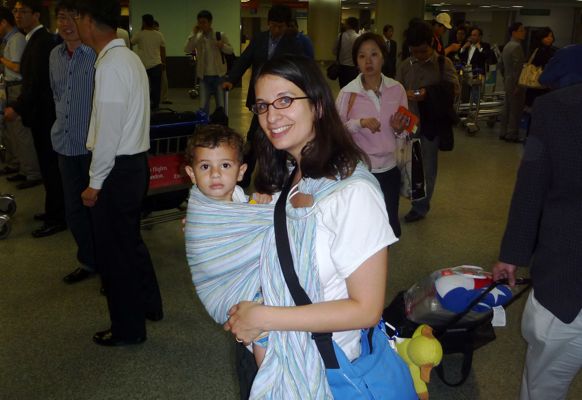
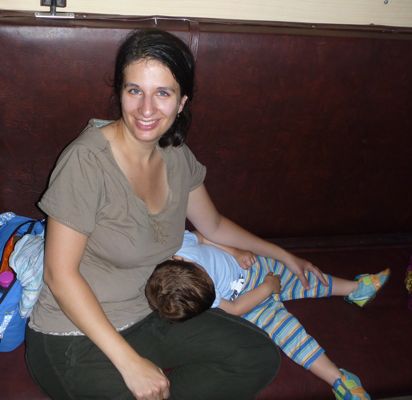
Above, first day, last day (in Mumbai): arrived at the airport our first night (along with a plane from South Korea), and just settled in on the train to Ahmedabad our last afternoon in the city.
We landed (at the same time as a Korean plane), and I popped Marcus into the double-layered linen sling (nice and airy), and quickly went through the baggage claim and through customs. There was a Jaguar waiting for us, sent by the hotel, with the poor driver who had been here waiting since before our plane was supposed to land (three hours earlier), and who had also been there the previous night waiting for our Air France plane. We felt bad, but the driver kept saying it was no problem, and that really what he does most of the time he’s “working” is wait for people. Robert, from here on, remained amazed at the cheap cost of labor all around us.
It was a forty-minute drive to the hotel, complete with small bottles of water and chilled washcloths, across the new bridge, overlooking the Queen’s necklace of Mumbai, and into the city proper. As the driver sped through red lights, Robert asked what a red light means here. “Stop,” said the driver, puzzled. “Oh, but you don’t have to stop at them?” Robert asked. The driver laughed. “Stop at night?” he said. “Nobody does that!”
We were staying at the Taj Mahal Hotel and Palace, which had just reopened after the terrorist attacks of November 2008, so the car was searched and scanned and we went through a metal detector to get into the hotel. After that, though, we were whisked up to our room—baby sleeping in the sling—which was beautifully air-conditioned and cool. They had glasses of watermelon juice for us, and a local mango, a baby banana, and some apples from Afghanistan (very sweet, and very slow to turn brown when cut, we later found out), and they did the check-in process in our room so we didn’t have to stand at a desk in the lobby. It was 2:30 in the morning when the hotel staff left, so we cut that gorgeous Alphonso mango, turned off the lights, and got in bed (Robert shivering and complaining about the temperature)--but no one ended up sleeping!
Marcus was very very good—he had woken up at some point when we were getting ready for bed, but just got into bed with us and nursed and lay there quietly for awhile. Periodically he would sit up questioningly, wondering what the heck time it was and why it was dark out, we were all lying down with eyes closed, but he felt like it was daytime. Eventually we just gave up and got up at 4:00—I’d slept really well on the plane, so I was fine, but poor Robert was exhausted, though still unable to sleep.
We took a bath, unpacked, ate the sweetest baby banana, and sat on our tiny balcony watching the sun rise. At 6:00 we went down for a little walk near the Gateway to India, the big arch—right across the street from the hotel—which was built to welcome King George in 1911. The steamy outdoor air hit us as soon as we exited the lobby—we had only felt it for a minute or two last night, between the airport door and the car, and the car and the hotel, but from now until we left India, we would get very used to the heat. Basically, days were 105 degrees F and higher, up to 110, 115, 118 degrees at some points. At night, it would cool off to a refreshing, oh, 90, 95 or so, with about that much humidity in the air too. I just got very used to being completely drenched with sweat when outside, to the point of having my shirt be soaked and my legs coated in rivers of sweat. Now, in the morning just after dawn, it wasn’t quite so bad, and it was actually a good first taste of Mumbai.
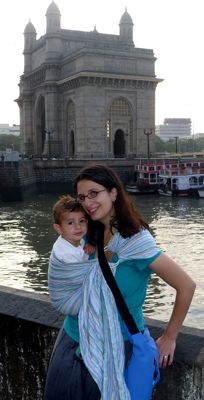
Above, walking near the Gateway to India right across from our hotel.
We watched the dogs—Mumbai is full of dogs, lots of strays, though they’re tamer than what we consider stray dogs here, and by the end of our trip, we were walking right up and petting them. This morning we were still a little cautious, though, and our baby, of course, super cautious. We saw pigeons, people exercising (doing a funny power-walk, mostly), bathing, selling chai, hanging out talking, selling newspapers, and staring at us. Over the next two weeks we would become very used to all of these sites, especially that last one. In fact, in some of our pictures you see one of us posing, and then a half dozen or more men (usually, but women too) staring right back at the camera.
The plaza was fairly empty, but by 5:00 it would be packed, almost wall-to-wall with people, with people strolling along and with balloon sellers and water sellers as well.
At 7:00 we went in for breakfast, the hotel buffet, which was included in our room but which we probably would have had anyway—it was a wonderful buffet, and we enjoyed it both mornings we were in Mumbai. There were cold and hot cereals; fresh, dried, and stewed fruits including mud apples; juices—mint-cucumber, sweet lime, orange, and watermelon, for your mixing pleasure; pancakes and waffles made to order; Indian congee; a few Asian dishes, dumplings, noodles, tofu, mushrooms; English breakfast items, including bacon, sausages, tomatoes, hash browns, and baked beans; Indian breakfast including dosas, idlis, rava, and all the chutneys and accompaniments; an egg bar with made-to-order chicken eggs, duck eggs, and quail eggs; yogurts and lassis; and a wide assortment of breads, Indian and western, including very good soft pretzels. We ate a lot. Robert sampled all the eggs, the pancakes, and the waffles, while I concentrated on Indian bread/breakfast items. Marcus ate a Thai fish cake and then played hide and seek behind the curtain and ran in circles around our table, while waiters (and the occasional businessman) looked at him adoringly.
We headed back to our room quickly after breakfast to get what we needed for the day, and then set off on a tour of the Dharavi slums of Mumbai, lead by Reality Travel, a small, friendly company started by an NGO which hires former slum dwellers as tour guides and channels ticket costs back into the community, offering computer classes, English classes, and a kindergarten. Our guide, Ganesh, met us in the lobby of our hotel and a car and driver (also from Reality Tours) met us all just outside. The tour takes about four hours, including driving to and from Dharavi, and we highly recommend it—it was a great, eye-opening way to start our first day in India. You’re asked not to take photos on the tour, out of respect for the people whose homes you are essentially invading, so we don’t have any pictures of that morning. This page has some pretty good shots, though, and seems representative of what we saw as well.
Our immediate impression, though, as we drove out of Colaba, was of the massive, fast-moving city around us. Now, Robert and I are New Yorkers. We like cities, we are used to them. We’ve lived in NY and LA, we’re used to jaywalking and hailing cabs and darting around slower pedestrians, you name it. Here, in Mumbai, we felt like country bumpkins: imagine that we were from the smallest towns in Iowa, Wyoming, Vermont, Maine, Alabama, wherever, with no experience whatsoever of a city, dropped into NY, and you will begin to get a taste of how shocking the city of Mumbai was to us. The traffic is absolutely overwhelming—cars everywhere, in and between lanes, and motorcycles or scooters too, everywhere, plus bikes, plus pedestrians, plus animals. Everywhere—street, sidewalk, crosswalk. Cows strolled by on the sidewalk or sat near an intersection for someone to feed and be blessed for a few rupees. Dogs wound in and out of people or lolled at the side of buildings in the heat. Horns honked constantly, in a never-stopping fugue. How on earth do people from small towns or suburbs in the US travel to India? We could not figure it out.
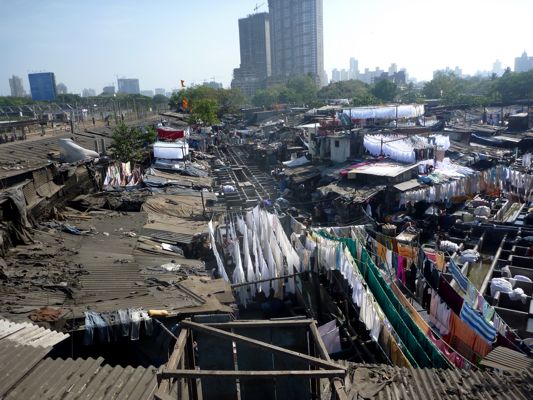 Despite the deafening din, Marcus fell asleep in the car not far from the hotel, so I snuggled him into a solarveil mei tai I had, while Ganesh looked on curiously. Our first stop (outside Dharavi proper) was at the dhobi ghat, the world’s largest outdoor laundry (left). Pictures don’t do this justice—it really was impressive to try to comprehend the scale of it. All but the fanciest hotels in Mumbai send their clothes here, we were told, and we looked at the little numbered bins for washing. The launderers get about five rupees per garment—that’s less than fifteen cents.
Despite the deafening din, Marcus fell asleep in the car not far from the hotel, so I snuggled him into a solarveil mei tai I had, while Ganesh looked on curiously. Our first stop (outside Dharavi proper) was at the dhobi ghat, the world’s largest outdoor laundry (left). Pictures don’t do this justice—it really was impressive to try to comprehend the scale of it. All but the fanciest hotels in Mumbai send their clothes here, we were told, and we looked at the little numbered bins for washing. The launderers get about five rupees per garment—that’s less than fifteen cents.
Back in the car, we drove to one end of Dharavi and the driver let us out, to meet up with us later on at an agreed-on spot. Ganesh and the driver are friends, and work together giving these tours almost every day, so they joke with each other, yell at other drivers on the street, and quickly switch from Hindi with each other to English with us. In the slum, everyone knows Ganesh (and the other Reality Tour guides). He greets people, smiles, makes small talk, grabs a snack from a vendor, buys a drink, and leads us in and out of the maze of alleys.
Dharavi is a massive hub of industry, which I guess I hadn’t been expecting. It’s home of one of the world’s biggest recycling industries, recycling paint cans, cooking oil cans, plastic bottles and bags and containers. In addition, there’s a huge pottery business and pappadums business. We went into lots of the factories to see the different parts of these manufacturing processes. “Factories” is a somewhat misleading word, though—they’re dark, no electricity either in use or else turned on at the moment, and more resemble Dickensian descriptions, or perhaps the recreated blacksmith shops at colonial restorations, than what we consider 21st century factories. We avoided the paint can factory because of the toxic fumes and the baby (this seemed to be the first time a baby was ever on one of these tours—no one quite knew what to make of it), but we saw everything else. We toured slippery-floored rooms where oil cans were stacked 30 high, we strolled bad-smelling yards where pappadums were drying on straw baskets amidst flies, and we climbed up two rickety ladders to the roof of an old storeroom to look out over the slum. Marcus slept soundly in the mei tai on my chest through the first two hours of this, and then woke up and stayed there, calm, awake, hot, and staring, through the next hour-plus as well.
In the plastics area, we saw a machine that makes little pellets from the recycled plastic, so they can then be melted down and formed into something else; this particular machine was actually invented, designed, and built right here in Dharavi, and everyone was very proud of it. They showed us how, on the wall, there was a switch so that it could actually be turned on when the electricity was on. There’s clearly real money made here, real contributions made to the world’s economy, but wow, what conditions.
A side benefit of this tour is that seeing this part of the city, the sanitation, and the conditions here made Robert very leery of street food. Whereas some people need to be made more adventurous when they travel, in Robert’s case, this reining-in of the adventurous spirit was actually an advantage that served us well for the remainder of our trip.
In the residential areas of the slum, people were very friendly. Kids came out and wanted to use their English on us. Hi, what’s your name, how old are you, what’s his name, how old is he, where are you from? Everyone pinched Marcus’s cheeks and went back inside and dragged out their own (bare-bottomed) babies to wave at Marcus. He was not completely sure what was going on, at this point—sweat was just pouring off his head, though he was constantly drinking from a bottle of water to instinctively rehydrate himself.
We stopped at a Muslim school for girls, run by another NGO, and I was allowed to go up with Marcus to talk to the teachers and peek into the classrooms. Because it was women-only, Robert and Ganesh stayed down in the courtyard below. The teachers included Ganesh’s fiancé, whom he actually met a little over a year ago while giving these exact tours. He’s Hindu, she’s Muslim, but the families seem to have finally come around, and they’re in the process of setting a date and planning the wedding.
At one point, when I was very very hot, we went into the community center and sat in the back during one of the computer classes just to sit inside in the shade with a fan moving the air around. The computer teacher held Marcus and paraded around with him and took a couple pictures. Robert and I were about as shell-shocked as our baby.
The driver picked us back up and we all went to lunch at a veg Punjabi restaurant, driving past lots of temples and mosques along the way. Tuesday is the god Ganesh’s day, so there were particularly large crowds of people outside the temple to Ganesh.
Dishes at the restaurant were 40-60 rupees each. We ordered malai kofta (veggie balls), one of my favorite dishes to order in Indian restaurants here in Boston, just to see what it would be like here. It did not disappoint—it was one giant conical kofta in a bowl of sauce, very delicious and spicy. We also got a mixed vegetable and paneer jalfrezi, yummy and spicy as well, with cheese and garlic naan. In the restaurant, we had a choice of eating inside in a warm room with a fan or outside under a canopy with a fan. Outside it was, still warm, though. We dutifully bought our bottled water and avoided ice (I think Robert despaired of ever getting a cold drink—the water we’d brought from the hotel in the morning was body-temperature when we drank it an hour later, and this water was, at best, what we’d think of as cool room temperature). For dessert I asked if they had am ras, since it was mango season, and Ganesh said yes, he thought they did, so they brought us two fabulous bowls of a rich, velvety mango puree—as far as I can tell, it’s just mango puree with cardamom, and you spoon the luxuriousness up as though eating a beautiful orange soup.
Marcus had a complete meltdown in the restaurant before the food got there—he was super tired, thinking it was night, hot, and unhappy, and for some reason he really wanted to run his hands through some ant-filled dirt near the plants behind our table—but I got him in my lap, calm, nursing, and then he fell asleep through the rest of the meal. He slid back into the mei tai after lunch and remained sleeping as we set out for the afternoon market tour we had also arranged for, Ganesh and our driver leading us again.
Though Robert and I are not generally organized tour people, these tours were really a good way to see Mumbai, which is just so spread out and daunting, especially for our first day in the country, that we would not have been able to go to these places on our own.
Below, standing on the street after our slum tour ended (this is not the slum, just a busy market street), and ogling the mangoes in Crawford Market.
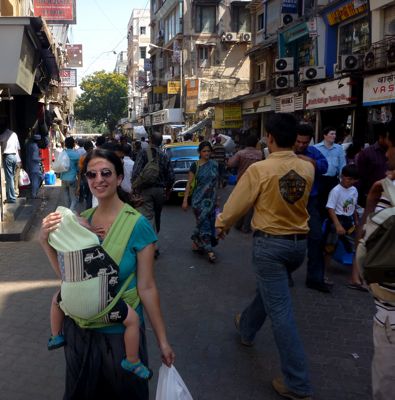
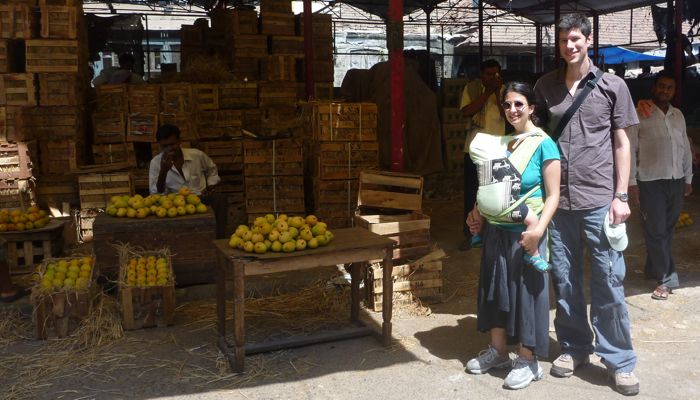
We drove to Crawford Market, where there truly were tons of mangos around, everywhere you turned. Most were Alphonsos, the so-called king of mangoes, which we had never had before the night before since they’re generally not imported to the US. Some of the Alphonsos are from Ratnagiris, which is supposedly where the best come from. We bought half a dozen Ratnagiris (more expensive) and half a dozen non-Ratnagiri Alphonsos for 180 rupees—less than $5. (As a comparison, we generally buy Kesar mangoes—also imported from India, and called the Queen of Mangoes—in the Indian stores in Waltham for $26-$30 for a box of twelve when they’re in—all too brief—season.) We walked through the pet market, the rest of the fruit market, and the fabric market, but we cut the rest of the market tour short, in part because we didn’t have any more money to buy anything else (we’d only gotten a small amount of rupees before we left), and in part because we were just absolutely exhausted by this point. For our final stop, we drove to the cow shelter, where 30,000 rescued cows are housed and fed. That’s a lot of cows. Marcus opened his eyes just as we got there, so he got to be eye-to-eye with a bunch of cows, which he called dogs.
All day, of course, we had seen in the streets and bulls pulling carts and stray goats (“Sometimes someone might catch them and milk them,” Ganesh said vaguely. “Really?” said Robert, “Free goat milk?”) and stray dogs—really, of course, what are we talking about? They’re all dogs.
We got back to the hotel at 3:30, and after we washed up quickly in our room, we ran down to the free high tea (and yes, that term is used appropriately in this case, though often it’s not) in the Sea Lounge in the old building of the hotel. We had a window booth looking out over the Gateway again, and we just loved the meal. There were three kinds of chaat (snacks) made to order—pani puri, stuffed puris, and papri chaat—plus many sandwiches (mutton sandwiches with spicy sauce were nice), lots of kinds of tea/coffee (Robert by now learned to ask for masala chai when he wanted what we just call here chai), burgers, fish cakes, dumplings, sweet breads, pastries, waffles cooked to order, mango mousse, chocolates, cucumber sandwiches, etc. We ate heartily, making supper of it, because I knew I was extremely close to sleep.
Around 5:30 we briefly went to the hotel’s business center to use their Mac (me) and PC (Robert) to send a quick email home, and tell our next hotel when we’d be arriving, before heading upstairs and going straight to bed.
Marcus and I slept soundly right from 6pm until 4:00 in the morning the next day, which is pretty darn close to being on the right time schedule. Robert did not sleep—he might have gotten four hours the whole night, but just as on the plane, Marcus and I slept well, and Robert virtually not at all.
On Wednesday May 12th a happy baby and well-rested Mommy woke up, and I declared us up for the day. We showered (here it’s worth noting that we stayed at fancy hotels in part so that we weren’t obsessively worried about swallowing the tap water when we brush our teeth or Marcus takes a bath—this hotel, and the others we stayed at, filters their bath water, and that appealed to us) and dressed and went down at 6:00 for another pre-breakfast stroll (also known as dog-gawking) and then another excellent buffet breakfast at 7:00.
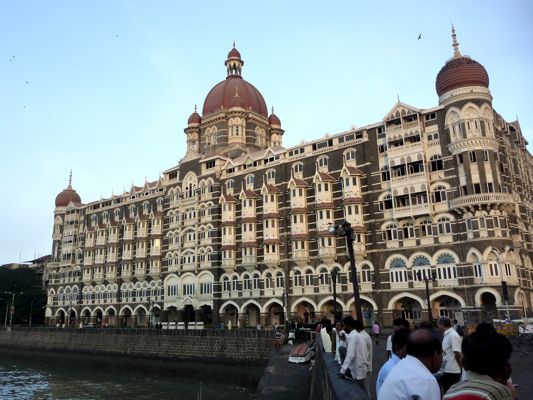
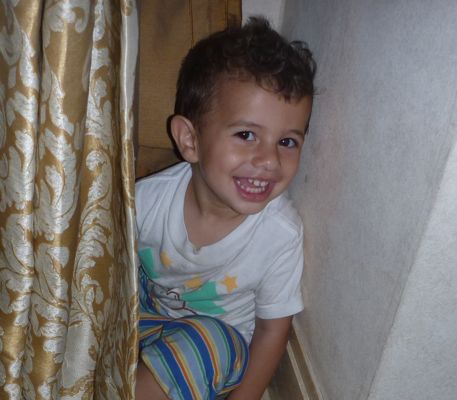
Above, our hotel (Taj Mahal Hotel and Towers) from the outside and inside (baby clowning around with the curtains in the room).
At 8:00, we met a hotel car and hotel driver for an abbreviated tour of southern Mumbai. We first stopped at Victoria station, which is full of commuters at this time of day, with people pouring off the trains before they’ve even stopped. Next we went to a Jain temple—beautiful, intricate (like a Russian church, like the Sistine Chapel), and bustling. Like virtually all other religious places in India, the temple was a no-shoes area—Marcus managed to cope with this, however, this time.
Our driver wanted us to call his mobile when we were ready for him to pick us up from the different places, but of course we had no (Indian) mobile. “No mobile?” this thought struck him as very strange. Over the next two weeks we got used to this reaction and indeed this entire conversation. One hotel offered to lend us SIM cards, but even that wouldn’t have helped us (still, we love our iPhones).
Next we went on to Nehru Park, a “children’s park,” but with no play structures that we saw, just some picnicking people who took Marcus’s picture and talked to him. This entire morning, we noticed the haze and smog in the city. We also noticed that today, in southern Mumbai, the cars were fancier and the neighborhoods lusher, the houses bigger, and the security tighter, than anywhere else we’d driven by. Across the street from the park was the Hanging Gardens, called that because it was built onto a hill, and now over a reservoir that gives Mumbai its water.
We enlisted the help of an older man in the Gardens who had already commented on Marcus to take a picture of the three of us together. “No, I simply can’t,” he said. “Your height difference is too great.” I had to stand on the lower rung of a fence in order to appease him, and he made us move three times to get an acceptable background.
Back in the car, we drove by the Zoroastrian tower where they hang out dead bodies for vultures, with our driver cheerfully explaining that sometimes a finger gets thrown onto the road by the vultures. Fingerless, we drove on to the tomb of Haji Ali, the biggest mosque in Mumbai. We had the mobile conversation again, and agreed to synchronize our watches and meet back in half an hour (which actually was cutting it a bit tight—forty-five minutes would have been better). The tomb is out at the end of a narrow causeway in the harbor; apparently the causeway gets wet at high tide but not impassable unless it’s during a monsoon. Still, when we walked down it, about half of it was in the splash zone, getting wet with each wave, and when we walked back (25 minutes later), about 2/3 of it was in the splash zone. I was nervous, but we made it.
This clearly would have been (perhaps was) a beautiful place, causeway and all, were it not for absolute mounds of trash washed up by the waves and deposited against the causeway like some sort of in-process landfill. Still, even with the trash, it was an amazing spot to see, and Robert and I were both really glad we made it out here.
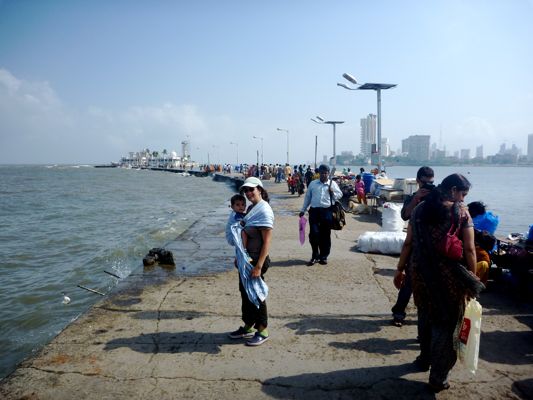 Left and below: the causeway over to the tomb of Haji Ali, complete with rising tide and animals.
Left and below: the causeway over to the tomb of Haji Ali, complete with rising tide and animals.
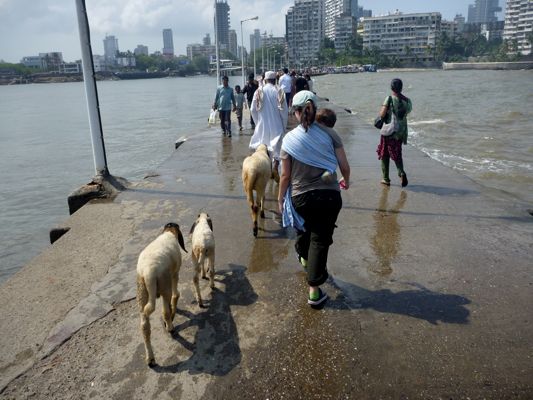
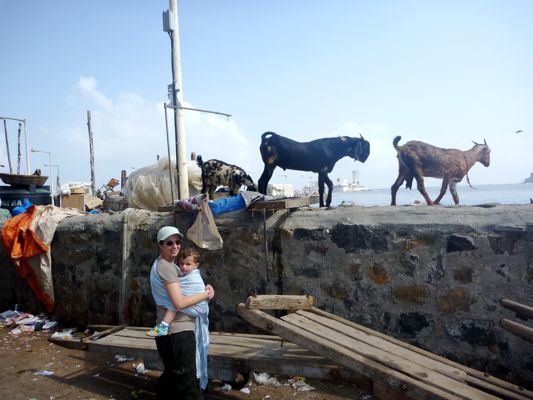
The causeway was lined with tables of vendors selling water, soda, chips, nuts, and dates, as well as sunglasses and hats and cheap toys. There were lots of goats, lots of families, and lots of babies (“Bo-ba!” Marcus said, pointing at every baby he saw). Everyone stared at us, and we were indeed the only westerners we saw (uh, actually in this entire day since leaving the hotel, but especially now). I had my head covered, and Marcus in the sling, and I swear a lot of women trying to juggle their babies in arms coveted my sling. Everywhere we went, actually, we saw people carrying their babies—families don’t leave their babies behind, but they don’t generally have strollers, either (we saw a total of six in all of India, four of those in a fancy mall in Delhi), so someone just carries the baby, and someone else carries the one-year-old when he’s cranky, and someone else carries the two-year-old when he’s passed out from sleep. Some teenage boys here sitting by the side of the causeway gave me a thumbs-up sign and said “You’re stylin’!” Uh, yes. In the US, that would clearly be sarcasm, but here, honestly, I couldn’t tell you what it was.
Once at the mosque, we left our shoes, even sleepy baby’s, with the shoe tender, then Marcus and I went to the women’s side and Robert to the men’s. The women’s side was so peaceful—cool marble floors to walk on, and lots of women and kids lying down. It wasn’t like church so much as like the lobby during the service. Everyone came over to see Marcus, pat his cheek, touch his leg. Someone gave me a date. The kids all said a shy hi.
We really had to hustle back to get to our driver and get back to the hotel by 11:00. Because of the mix-up with our plane and the wind delay, we missed an entire day in Mumbai, so we were now scheduled to leave on just our second day in the city. We washed up, packed, popped sleeping baby back into the sling, and took the hotel car to the Bandra train station to move on to our next stop. We loved our hotel and Mumbai, though, and hope someday to come back (eat that great breakfast again) and spend another few days here in a less-rushed way.